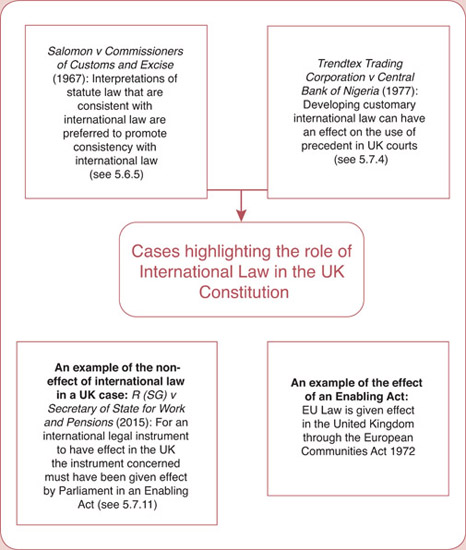THE ROLE OF INTERNATIONAL LAW

5
The role of international law

5.1 What is international law?
5.1.1 Wallace and Martin-Ortega have written a most useful definition that contemporary international law ‘refers to those rules and norms that regulate the conduct of States and other entities …’.
5.1.2 Such ‘other entities’ include supranational organisations such as the European Union, for example, and the Council of Europe – addressed across the next two chapters of this book (see Chapter 6 and Chapter 7).
5.1.3 International law as a whole comprises public international law (which is the focus of this chapter) and private international law, often known as the ‘conflict of laws’.
5.1.4 Public international law is concerned with agreements between two or more different jurisdictions, in the form of a treaty, for example, or at a supranational level. This international agreement may then be binding on the State institutions in the two (or more) jurisdictions or States concerned. Often these agreements will concern matters of public law, or particularly human rights law, in the UK context.
5.1.5 Private international law, or the ‘conflict of laws’ is the body of international law which concerns the resolution of legal disputes between two private bodies across two or more jurisdictions, in a context, for example, of commercial law.
5.2 The development of international law
5.2.1 Wallace and Martin-Ortega have noted that the traditional definition of ‘international law’ as a body of rules regulating the conduct of States at times of peace, and indeed war, between themselves is now too narrow, particularly with the growth of considerable international trade law, and much international human rights law, as well as international criminal law.
5.2.2 Public international law as a body of rules aiming at promoting international justice (including, e.g., the prevention of crime and discrimination, the promotion of human rights values and protection of the environment) is only as successful as the political will to recognise it in any given State jurisdiction.
5.2.3 The international legal system we have today has developed most quickly in the second half of the 20th century and the early 21st century.
5.3 Sources of international law
5.3.1 Sources of international law can be described as either formal (articulating what the law is) or material (identifying where the law is to be found).
5.3.3 The international legal system possesses no ‘written’ or codified constitution as a single document – something it has in common as a legal system with the constitution of the United Kingdom. So the development of the recognition of sources of international law is not, and cannot be, entirely uniform.
5.3.4 But in Article 38 of the UN Statute on the International Court of Justice, categories of different sources of international law are set out, which are very useful examples for the purposes of this short introduction to international law.
5.3.5 In accordance with Article 38, for example, the International Court of Justice decides cases brought by UN member States against other UN member States specifically in international conventions (including international treaties) and international custom.
5.4 Custom in international law
5.4.1 Just as convention in the UK constitution is important to a fuller understanding of the constitution itself, so too the notion of custom as a source of international law is important in gaining an understanding of the international legal system as a whole.
5.4.2 Custom in international law is a body of rules or norms with which States comply because they feel they ought to, legally, or have complied with consistently.
5.4.3 Whether a particular behaviour by a State over a period of time, at an international level, can be considered customary international law, is defined by several factors, including:
- • the duration of the practice of that behaviour between States; and
- • the consistency and uniformity of that practice between States.
5.4.5 Key to a determination in the International Court of Justice as to whether some particular State behaviour is actually ‘crystallised’ into international law as customary international law is the notion of opinio juris sive necessitatis: ‘an opinion of law or necessity’. Opinio juris, as it is often more simply known, is the subjective belief by a State itself that it is bound in customary international law to follow a particular course of action.
5.4.6 If a particular practice by a State with regard to other States is both (a) largely consistent and uniform over a period of time, and (b) believed by that State to be a legal obligation (fulfilling the criterion of opinio juris) then the practice can be determined to be part of customary international law.